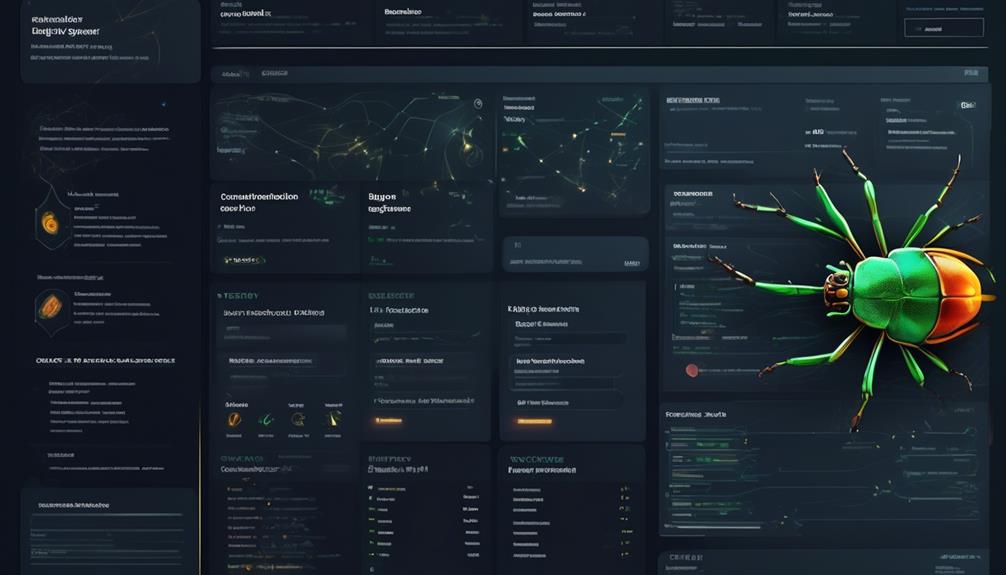Have you perfected the skill of identifying software bugs? Let’s delve deeper into the true essence of this skill.
There's more to it than just running a few tests and calling it a day. The world of software quality assurance and bug testing is a complex one, and there are numerous considerations to take into account.
But fear not, we're here to guide you through the essential steps and best practices for ensuring the reliability and performance of your software.
Keep reading to uncover the key insights into how to effectively test bugs and elevate your software quality assurance game.
Key Takeaways
- Understanding the different types of software bugs, such as syntax errors, logic errors, runtime errors, memory leaks, and buffer overflows, is crucial for effective bug testing and resolution.
- Categorizing and prioritizing bugs based on severity and impact helps in efficiently addressing and fixing them.
- Bug identification and resolution processes should involve meticulous issue tracking, real user testing, realistic deadlines, root cause analysis, and detailed insights provided to the development team.
- Bug reporting and communication play a vital role in software quality assurance, including providing essential details, proper classification and prioritization, effective analysis, collaborative communication, and the oversight of the testing process by a Test Manager.
Understanding Software Bugs
Understanding the various types of software bugs is crucial for ensuring the reliability and functionality of a software system.
Software bugs, such as syntax errors, logic errors, and runtime errors, can lead to inaccurate or unexpected outputs.
Additionally, memory leaks and buffer overflows are common types of software bugs that can significantly impact the performance and stability of a software application.
To effectively identify and rectify these bugs, it's essential to utilize a combination of testing approaches and tools.
Comprehensive testing, including unit testing and integration testing, can aid in finding software bugs early in the development process.
Automated testing tools and performance testing can further assist in uncovering bugs related to system resource management and efficiency.
Once a software bug is identified, proper bug tracking and communication with the development team are imperative.
Accurately documenting and prioritizing bug fixing based on severity and impact is crucial for efficient bug resolution.
This approach streamlines the bug-fixing process, enhances overall software quality, and improves workflows in software testing and quality assurance (QA) testing.
Bug Classification in Testing

Bug classification in testing involves systematically categorizing and prioritizing bugs based on their nature and impact to streamline the bug-fixing process. Proper classification allows for efficient allocation of resources and timely resolution of issues, contributing to the overall quality of the software. We can classify bugs based on their severity, such as critical, major, or minor, and also by priority, determining the urgency of their resolution. Below is a table outlining the types of bugs and their impact on the software:
| Type of Bug | Impact on Software |
|---|---|
| Functional Defects | Affect core software functions |
| Performance Defects | Degrade system performance |
| Usability Defects | Impact user experience |
| Security Defects | Pose potential security risks |
Understanding the types of bugs is essential for creating effective test cases and ensuring thorough testing. By classifying bugs accurately, QA teams can prioritize efficiently, focusing on finding and fixing high-impact bugs, ultimately improving the software's performance and reliability.
Testing Process for Bug Identification
When identifying bugs during the testing process, we utilize bug tracking systems to meticulously keep track of each issue and its impact on the software's functionality. This allows us to effectively prioritize and communicate bug reports to the development team, ensuring that they've all the necessary information to address the identified issues.
We also conduct testing under real user conditions, using real browsers and devices to simulate how the software will perform in the hands of actual users. This approach helps us uncover potential bugs that may only manifest themselves in specific environments.
In addition, we define realistic and achievable deadlines for bug fixes, taking into account the severity and complexity of each issue. This ensures that the development team can focus on resolving critical bugs while also addressing less severe issues within a reasonable timeframe.
Furthermore, we analyze each bug to understand its root cause and underlying factors, allowing us to provide detailed insights to the development team for efficient resolution.
Types of Software Bugs

During our software quality assurance testing, we encounter various types of bugs, each with its unique impact on the software's functionality. These include:
- Syntax errors, which result from incorrect code formation or the presence of invalid characters.
- Logic errors, where the code doesn't behave as intended.
- Runtime errors occur during program execution.
- Memory leaks and buffer overflows can lead to wastage or inadequate handling of memory and corruption of data.
Identifying these types of defects is crucial for effective software testing. Our QA team employs both manual and automated testing methods to detect these bugs, ensuring thorough examination of the system to uncover any issues.
Once identified, the severity of each bug is assessed and communicated to the development team to prioritize and address them accordingly.
Understanding the nature of these software bugs is essential for the comprehensive testing of software systems, helping to enhance the overall quality and reliability of the end product.
Importance of Reporting Bugs
As we progress in our software quality assurance testing, the thorough identification and reporting of bugs become pivotal for ensuring the accurate and expected performance of the software.
Reporting bugs is of utmost importance as it provides essential details for developers to understand, reproduce, and effectively resolve the issues.
Proper bug classification and prioritization streamline the bug-fixing process, thereby enhancing the overall software quality.
Moreover, effective bug analysis aids in identifying the root cause and underlying factors of the issue, enabling the creation of new, automated tests to prevent similar bugs in the future.
Collaborative communication and bug prioritization are essential for timely bug resolution and improved software performance.
Test Manager's role in overseeing the comprehensive software testing process, analyzing test results, and ensuring the accurate reporting of bugs can't be overstated.
Therefore, in the realm of software testing, the importance of reporting bugs is undeniable as it directly contributes to the creation of reliable and high-quality software products.
Frequently Asked Questions
How Do QA Testers Find Bugs?
We find bugs through thorough and systematic testing of software applications. Utilizing various testing tools and approaches, we identify bugs and communicate their details to the development team.
Bug prioritization is crucial for focusing on high-priority bugs and ensuring timely resolution. Real-world environment testing and collaboration with developers are essential for efficient bug analysis and resolution.
Do QA Testers Fix Bugs?
Yes, QA testers do find and document bugs, but typically don't fix them. Once a bug is identified, we communicate it to the development team. The development team fixes bugs based on our bug report.
Our bug report covers details like occurrence, expected result, root cause, and solution. Bugs are then categorized into different types for proper management, such as functional, business, or GUI.
How Do You Identify a Bug in Software Testing?
In software testing, we identify bugs through meticulous analysis and rigorous testing. We scrutinize every aspect of the software, from functionality to user interface, uncovering even the most elusive bugs.
We employ a range of testing techniques, including boundary analysis and equivalence partitioning, to ensure thorough bug detection. Our keen attention to detail and analytical approach allow us to identify bugs with precision, ensuring the highest quality software.
What Are the Techniques of Bug Testing?
We use various techniques for bug testing, such as static analysis, unit testing, integration testing, fuzz testing, and debugging tools.
Each method serves a specific purpose in our quality assurance process.
Static analysis tools help us uncover potential flaws in the code, while unit testing ensures individual software components function as expected.
Integration testing examines how different units work together, and fuzz testing generates random inputs to identify potential program crashes.
Conclusion
In the intricate dance of software testing, identifying and reporting bugs is like shining a light on hidden obstacles. By understanding the different types of bugs and categorizing them effectively, we can navigate the path to reliable software.
The art of bug testing is a vital step in the journey towards quality assurance, and it requires careful attention to detail and clear communication to ensure a smooth and reliable software experience.









